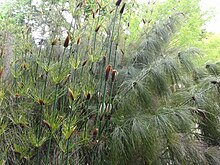Restionaceae
| Restionaceae Temporal range: Late Cretaceous-Recent, 66–0 Ma PreЄ Є O S D C P T J K Pg N | |
|---|---|
 | |
Elegia capensis | |
Scientific classification | |
| Kingdom: | Plantae |
Clade: | Angiosperms |
Clade: | Monocots |
Clade: | Commelinids |
| Order: | Poales |
| Family: | Restionaceae R.Br.[1] |
The Restionaceae, also called restiads and restios, are a family of annual or perennial rush-like flowering plants native to the Southern Hemisphere; they vary from a few centimeters to 3 m in height. Following the APG IV (2016):[2] the family now includes the former families Anarthriaceae, Centrolepidaceae and Lyginiaceae, and as such includes 51 genera with 572 known species.[3] Based on evidence from fossil pollens, the Restionaceae likely originated more than 65 million years ago during the Late Cretaceous period, when the southern continents were still part of Gondwana.[4]
Contents
1 Description
2 Distribution
3 Classification
3.1 Genera
4 References
5 External links
Description
The family consists of tufted or rhizomatous, herbaceous plants, rush-like or bamboo-like in overall appearance. They belong to a group of monocotyledons that includes several similar families, such as the sedges, rushes, and true grasses. They have green, photosynthetic stems and leaves that have been reduced to sheaths. Their flowers are extremely small and in spikelets, which in turn make up the inflorescences. Male and female flowers are on separate plants and, like grasses, are wind-pollinated.
Distribution
Plants in the family are distributed on all the southern continents - South America (1 sp., Apodasmia chilensis), Africa south of the Equator and including Madagascar (about 330 spp.) and Australia (about 150 spp.) - in New Zealand (four spp.) and widely distributed in Southeast Asia (one sp.). They are often dominant elements of the flora in the Mediterranean climates of South Africa and Western Australia. They are the defining family in the Western Cape fynbos plant community.[5] The South American species is very similar to one of the New Zealand species, leading to the conjecture that it might have crossed the Pacific in the last 30 million years. The distribution of restios in Africa is irregular, with the same single species occurring in Madagascar, the Democratic Republic of the Congo, Tanzania, and Malawi, while a different species is found in the Chimanimani Mountains of eastern Zimbabwe. Four species are found in the Natal Drakensberg, one of which spills over into Mpumalanga and Limpopo provinces. The vast majority of species, though, are to be found in the Cape Floristic Region and particularly plentiful on hard sandstone formations. The center of diversity lies in the Kogelberg, where more than a third of all Restionaceae may be found.[6] Restionacea can be found in Kirstenbosch, Cape Town's National Botanical Gardens.
A number of the largest African species have become popular as garden ornamentals in many parts of the world, some being useful as accent plants similar to small species of bamboo, but with pendant stems of greater delicacy. Also, many smaller species offer a great variety of decorative features and deserve horticultural attention.
Classification
The Restionaceae family has been recognized by most taxonomists. The AP-Website [May 2006] assumes 58 genera and 520 species, which agrees well with the Flora of China.
The APG II system of 2003 (unchanged from the APG system, 1998), recognizes this family and assigns it to the order Poales, in the clade commelinids of the monocots.
The Cronquist system of 1981 also recognized this family and placed it in the order Restionales, in the subclass Commelinidae in class Liliopsida in division Magnoliophyta.
Genera
The genera in the Restionaceae are:
Alexgeorgea, Anarthria, Anthochortus, Aphelia, Apodasmia, Askidiosperma, Baloskion, Calorophus, Cannomois, Centrolepis, Ceratocaryum, Chaetanthus, Chordifex, Coleocarya, Dapsilanthus, Desmocladus, Dielsia, Elegia, Empodisma, Eurychorda , Gaimardia, Harperia, Hopkinsia, Hydrophilus, Hypodiscus, Hypolaena, Lepidobolus, Leptocarpus, Lepyrodia, Loxocarya, Lyginia, Mastersiella, Meeboldina, Megalotheca, Nevillea, Onychosepalum, Platycaulos, Restio, Rhodocoma, Sporadanthus, Staberoha, Thamnochortus, Willdenowia and Winifredia.
References
^ Angiosperm Phylogeny Group (2009). "An update of the Angiosperm Phylogeny Group classification for the orders and families of flowering plants: APG III" (PDF). Botanical Journal of the Linnean Society. 161 (2): 105–121. doi:10.1111/j.1095-8339.2009.00996.x. Retrieved 2013-07-06..mw-parser-output cite.citationfont-style:inherit.mw-parser-output .citation qquotes:"""""""'""'".mw-parser-output .citation .cs1-lock-free abackground:url("//upload.wikimedia.org/wikipedia/commons/thumb/6/65/Lock-green.svg/9px-Lock-green.svg.png")no-repeat;background-position:right .1em center.mw-parser-output .citation .cs1-lock-limited a,.mw-parser-output .citation .cs1-lock-registration abackground:url("//upload.wikimedia.org/wikipedia/commons/thumb/d/d6/Lock-gray-alt-2.svg/9px-Lock-gray-alt-2.svg.png")no-repeat;background-position:right .1em center.mw-parser-output .citation .cs1-lock-subscription abackground:url("//upload.wikimedia.org/wikipedia/commons/thumb/a/aa/Lock-red-alt-2.svg/9px-Lock-red-alt-2.svg.png")no-repeat;background-position:right .1em center.mw-parser-output .cs1-subscription,.mw-parser-output .cs1-registrationcolor:#555.mw-parser-output .cs1-subscription span,.mw-parser-output .cs1-registration spanborder-bottom:1px dotted;cursor:help.mw-parser-output .cs1-ws-icon abackground:url("//upload.wikimedia.org/wikipedia/commons/thumb/4/4c/Wikisource-logo.svg/12px-Wikisource-logo.svg.png")no-repeat;background-position:right .1em center.mw-parser-output code.cs1-codecolor:inherit;background:inherit;border:inherit;padding:inherit.mw-parser-output .cs1-hidden-errordisplay:none;font-size:100%.mw-parser-output .cs1-visible-errorfont-size:100%.mw-parser-output .cs1-maintdisplay:none;color:#33aa33;margin-left:0.3em.mw-parser-output .cs1-subscription,.mw-parser-output .cs1-registration,.mw-parser-output .cs1-formatfont-size:95%.mw-parser-output .cs1-kern-left,.mw-parser-output .cs1-kern-wl-leftpadding-left:0.2em.mw-parser-output .cs1-kern-right,.mw-parser-output .cs1-kern-wl-rightpadding-right:0.2em
^ Angiosperm Phylogeny Group (2016), "An update of the Angiosperm Phylogeny Group classification for the orders and families of flowering plants: APG IV", Botanical Journal of the Linnean Society, 161 (2): 1–20, doi:10.1111/boj.12385
^ Christenhusz, M. J. M. & Byng, J. W. (2016). "The number of known plants species in the world and its annual increase". Phytotaxa. 261 (3): 201–217. doi:10.11646/phytotaxa.261.3.1.
^ Bremer, K. (2002). "Gondwanan Evolution of the Grass Alliance of Families (Poales)." Evolution, 56(7): 1374-1387. [1]
^ Linder, H. Peter; Pia Eldenas; Barbara G. Briggs (2003). "Contrasting patterns of radiation in African and Australian Restionaceae". Evolution. 57 (12): 2688–2702. doi:10.1111/j.0014-3820.2003.tb01513.x. PMID 14761050.
^ Restios of the Fynbos - Els Dorrat Haaksma, H. Peter Linder (Botanical Society of South Africa, 2000)
External links
| Wikimedia Commons has media related to Restionaceae. |
Florabase [218 entries, in Restionaceae sensu lato]
